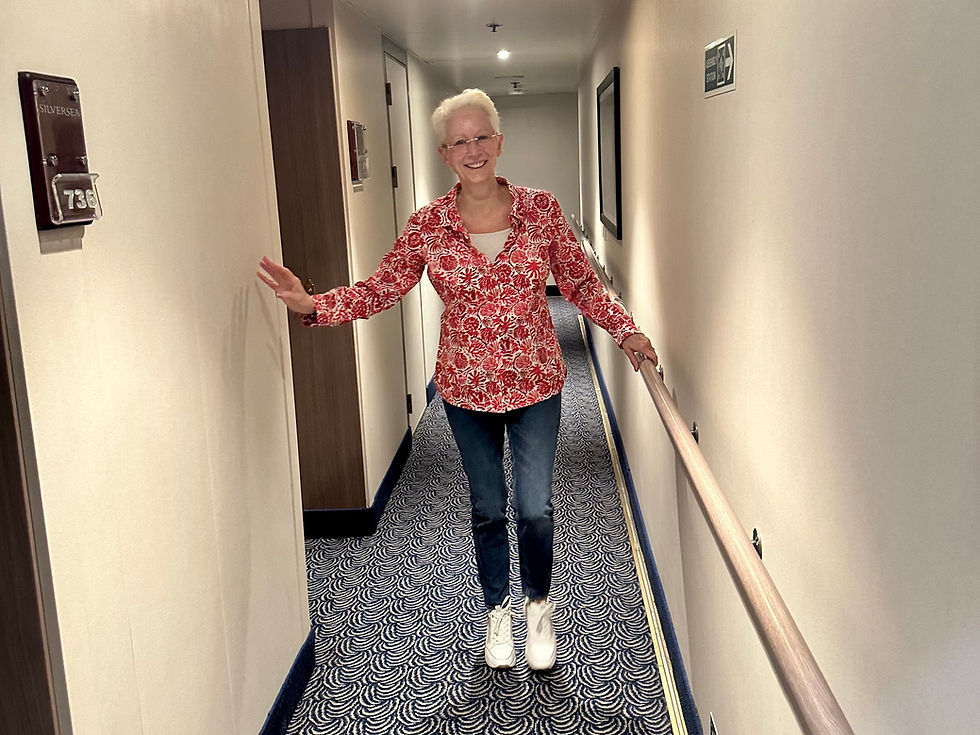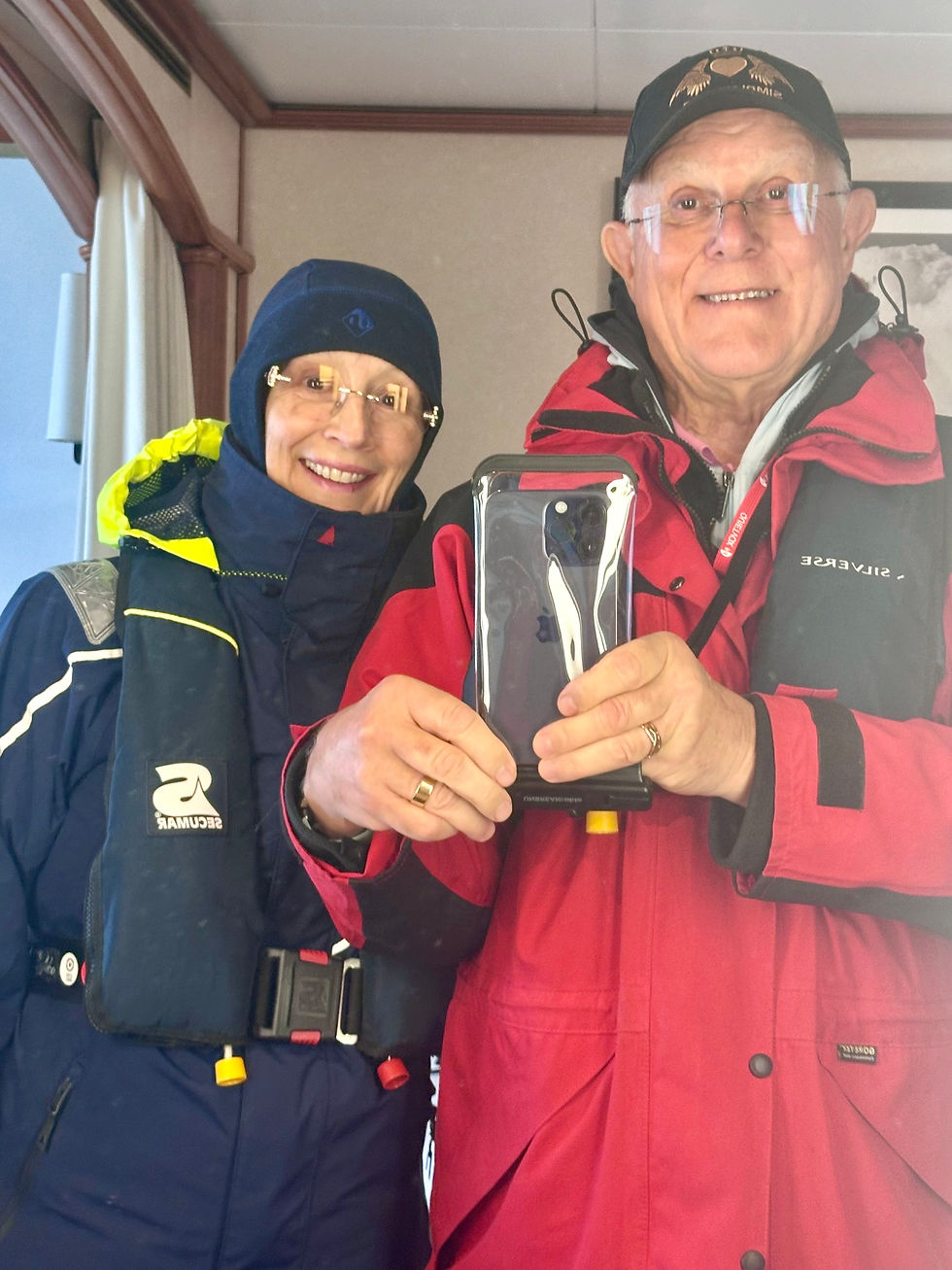A heavy night and last thoughts of Iceland
- Nick Evans
- Jun 29
- 4 min read

Stormy it was. And still is. Our sleep in the night was disturbed and the ship pitched and yawed in heavy seas giving us a very bouncy ride. The morning has dawned bright and the sea has calmed down a little so we can at least get out of bed without fearing for our lives.
I suggest to Gabrielle that we could make it to breakfast. Apparently I am on my own, or so she says. In the end, she finds her big girl pants which had temporarily gone missing, gets up, showers, dresses and we head rather belatedly to breakfast.
The restaurant is of course in the stern of the ship and so the motion is emphasised here. As we stumble our way there along the corridors the ship continues to lurch and pitch. Almost as soon as we arrive there is a series of crashes from the buffet where trays are dropped and then someone unwisely opens a cupboard containing half empty wine bottles. With a smash, they hit the floor and suddenly the buffet area is swimming in red wine. Gabrielle, meanwhile, is incapable of addressing the from challenge of getting food and so I trot off in search of fruit, omelette and toast while she orders coffees and water.
Gabrielle is plotting the many ways in which she is going to make me suffer a slow death for making her come on another cruise. I think reminding her that it was her idea at this point is not diplomatic. Nonetheless she eats her food and it appears to stay down - something that both of us surmise would not have been the case if we had met this weather on the way out to Iceland.
At around midday, Gabrielle springs back to life, sits up in bed and decides she is a princess! Coffee, chocolate, water and juice are to be provided while she sits in state. At the same time the Captain comes on the tannoy to tell us that the weather is bumpy. We look out of the window and confirm that he is correct. Moreover, this weather will continue pretty much until we reach Iona. The overview is that we have covered 237 nm since we left Seyðisfjörður at an average speed of 14.6 knots. There are 306 nm to go to Iona. The wind is 25 knots which represents 6 to 7 on the Beaufort scale. The barometer is rising meaning that the low pressure storm is moving away and we have 3060 feet of water beneath the keel.
So our day at sea is to be a gentle one, not straying from our room other than to eat and largely sitting and reading or in Gabrielle’s case, lying down groaning. Actually, she isn’t groaning but it just seemed more dramatic.
We have had two stalkers everywhere we have been on this trip and, last night, they finally corner us and force us to break our rigid rule on no fraternisation when they finally track us down. Tim and Lucy are sitting at the table next to us and they quickly reveal that they live only about twelve miles away from us, in Highcliffe. It’s quickly evident that we have quite a bit in common and so the chat goes on into the evening. They seem to pop up on each excursion we are on, often on the same bus. And then we work it out: they are in Orange Group, the same as us. This massively increases the chances of our paths crossing.
Now, as we have left Iceland and are plunging through the North Atlantic towards Iona, what have been our thoughts about the place? It’s a land of towering mountains, waterfalls and glaciers where the weather is largely cold and wet with occasional flashes of sunshine. It’s been strange wearing long johns while the rest of Europe bakes in exceptional temperatures.
Iceland has the quietest roads in Europe but the longest distances to get anywhere, winding around the shores of huge fjords with mountains towering over you. To say the scenery is dramatic seems like a huge understatement and photos can never do it justice.
It’s a country with a small population - around 390,000, but a high GDP per head and great wealth in terms of energy. Its “cities” are at most just small towns and the greater part of the population lives in Reykjavik, which we did not visit. The Ring road circles the country and connects Reykjavik to other coastal towns. It takes 17 to 20 hours to drive completely round it and some people do it as a tour in anything up to 8-10 days.
Geomorphology plays a huge part in understanding Iceland and its origins. It’s a young country geologically speaking, born from the separating tectonic plates that allow magma to flow to the surface and build new land. This is an ongoing process as the North American and European plates continue to draw apart at the Mid Atlantic Ridge. Volcanic activity is all around in everything from lava flows to bubbling mud pools, from geothermal hot springs to the smell of sulphur.
Plant life in Iceland appears to be dominated by two things: lupins and the lack of trees. The former were introduced in order to put nutrients back into poor soil so that agriculture and tres could have a chance. Although the country has not always been treeless, there are only a few places where any quantity of low beech trees grow. The cruel winters destroy young saplings and so reforestation is a real challenge. Lupins meanwhile appear to thrive everywhere and are now considered to be an invasive species.
This is a country of wild beauty and stark conditions. It’s both welcoming and hostile, in that the people are friendly and proud of their European tradition but the climate is fierce.
And finally from me for this post: writing this blog is always a technical challenge. We write wherever we can - on a bus, sitting in the rain, in our room. And likewise, actually creating the post in the blog, post processing our chosen photos and then bringing together all the content takes time and effort. The remarkable thing about it on this journey is that everything has been done on our iPhones. No computer, no iPad. Just two iPhones and a lot of looking like teenagers as we huddle over the latest content.



Comments